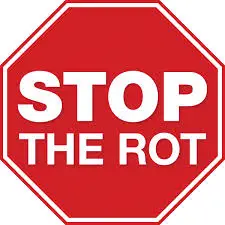If you are a Windows user, you know this ! As time passes by your once snappy Windows starts becoming less responsive. The problem is that its a process that just seems to occur over a period of time…without any warning! Over time, the performance gradually starts degrading! Usually the machine just starts freezing more often or giving the Blue Screens frequently. The only cause for this is a long period of (heavy) use. And the most to be affected after the rot sets in, is the Windows Explorer and Internet Explorer!

Windows Rot
Windows Rot is defined in the Urban Dictionary as the process by which a Windows machine becomes progressively slower the longer you use it and the more software you install on it. This condition is generally ascribed to a deterioration of the Windows Registry, caused by applications that use it improperly and don’t clean up after themselves.
You may have experienced Windows Rot in Windows XP, and may have noticed that its intensity has been reducing with each new version of Windows – and the Rot is less pronounced. This is because Microsoft has now virtualized some files & the registry. File & Registry Virtualization basically means that, applications are prevented from writing to System Folders in Windows file system and ALSO to the ‘machine wide keys’ in the registry.
Call it the natural aging of Windows, if you wish, but then there are a few steps or precautions one can take to prolong this process. Here are some :
1) Avoid installing and uninstalling too many software. The more software you install/uninstall, the more sluggish you can expect your machine to get gradually. Many programs leave their traces in the registry, even after they are uninstalled. At times even program folders or components of installed applications are left behind when the programs are uninstalled. Sometimes un-installations just go wrong leaving a mess behind. So best to be very clear of what you want. These days with so much crapware being pre-loaded on an OEM machine, this gets even worse!
2) Do not install too many fonts. Every new font you install uses memory. Having just too many fonts takes its toll on Startup. To check out how many fonts your machine has, Go to the Control Panel and click open the Fonts icon. Having around 500 fonts should be just good enough. Select fonts you know you don’t need, right-click, and click Delete. Do take care that you don’t end up deleting System fonts. If you need to have more fonts, use a good Font Manager to enable/disable fonts on the fly as and when you require them.
3) Avoid installing warez and be careful with Freebie Offers! Stay away from shady websites which promise you free pirated websites, cracks, games, screensavers, music, etc, as you’ll never know when your machine will be hit by spyware! Even though you may end up removing it with your anti-malware, the damage will have been done.
4) Remove add-ons: Frequently check up your start-up programs, File Explorer extension, and Browser add-ons, and remove or disable the ones you don’t need. The same holds for toolbars too.
5) Take care of your PC! Use a good Junk Cleaner & Optimizer, to identify and delete the junk files, invalid registry entries, and invalid shortcuts, regularly. A monthly run is good enough, but if you use your PC and/or surf intensively, a weekly run should be fine too! Defragment your Registry and your Disks too occasionally. Also, run your antivirus and anti-spyware software regularly. Make these a monthly habit, at least.
Windows 10 offers you the Refresh & Reset PC features which are really helpful features, to make your Windows snappy & responsive again, as good as new, without going through the rigmarole of a fresh install!
If you are looking to fight Windows Rot, here are two more links that will interest you:
- Beginners tips to optimize Windows for better performance
- How To Make Windows Start, Run and Shutdown Faster.
Do let us know if you are facing this gradual slow-down and freezing in Windows 10, Windows 8.1 or Windows 7 too.
Post updated and ported from WVC